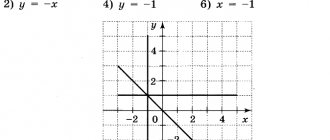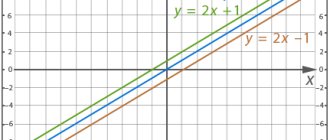Lesson summary “Coordinate plane” for 6th grade
a) creating a problem situationWhat do we know about coordinates? Where have we met them before?
Coordinate ray, coordinate line
Why do we need coordinates? How do coordinates help us?
(In order to determine the position of an object
)
Where in life do we meet them?
What does the phrase “leave me your coordinates” mean?
- geographical coordinates
- place in the hall
- games
- student’s place in the exam Indeed, the essence of coordinates is that we can determine the position of this or that object. In mathematics lessons we determined the position of a point.
b) familiarization with the coordinate system
— How to determine the position of point A (2)?
— How the coordinate line can be located (not only horizontally, but also vertically, positive to the right or above the origin)
How can we mark the coordinates of point B(2;3). if we had one coordinate and one line, then here ... (2 coordinates, which means there will be two coordinate lines)
- What happens if you combine them? (two intersecting lines, perpendicular).
-What should be noted? (Point 0 is the origin of coordinates, select unit segments on the axes) These straight lines are called a coordinate system.
Where are the straight lines located? (on the plane) means, as we call it, a coordinate system on the plane. What is the name of the plane where the coordinate system is chosen? (coordinate plane)
point B has two coordinates. The first one shows the position of the point relative to the x-axis (2 segments to the right), the second 3 – the position relative to the y-axis (3 segments up)
— What is the name of the plane in which the coordinate system is chosen?
(coordinate plane)
So, that means the topic of our lesson
…
(Coordinate plane)
Goals
Познакомиться
with a coordinate system, find out what the axes are called
Learn
determine and name the coordinates of a certain point, mark a point on the coordinate plane
To figure out
the history of the appearance of the coordinate system, features of the construction of some points
The coordinate plane is also called a rectangular coordinate system or Cartesian coordinate system. Why do you think?
How are our lines x and y located relative to each other? (perpendiculars mean they intersect at right angles)
R. Descartes - French philosopher, natural scientist, mathematician.
He first introduced the rectangular coordinate system in his work “Discourse on Method” in 1637.
Descartes used special words to name the coordinates of a point on the plane M(x;y)
Abscissa - from Latin “cut off, segment”
Ordinata - from Latin means “located
in order"
Coordinate – Latin means “jointly ordered”
You have reference material
. take it out and study it.
What are the coordinates of a point called? (a pair of numbers showing the position of the point)
What is the abscissa? ordinate?
Which straight line is called the abscissa axis? ordinate axis?
Look at our axes intersecting, what is formed (4 corners)
The plane is divided into 4 parts or quarters. Indicates 1, 2, 3, 4 quarters
Lesson summary “Coordinate plane” in mathematics for 6th grade
Patekhina Ekaterina Petrovna
OGBOU "Smolensk Special (Correctional) General Education School of Types I and II" (Center for Distance Education), Smolensk
Teacher of mathematics and computer science
Math lesson in 6th grade on the topic: “Coordinate plane”
Module name:
coordinate plane
.
Integrating didactic goal :
introduce students to the rectangular coordinate system on a plane, the basic concepts of the topic (origin, coordinate plane, abscissa of a point, ordinate of a point, abscissa axis, ordinate axis), teach them to solve problems on this topic.
Target action plan for students:
- get acquainted with the rectangular coordinate system on a plane, the basic concepts of the topic,
- teach how to freely navigate on the coordinate plane, build points according to its given coordinates and determine the coordinates of a point marked on the coordinate plane; perceive coordinates well by ear; carry out geometric constructions clearly and accurately,
- develop creativity, logical thinking, memory,
- cultivate interest in the subject.
Bank of information
a) input control of students’ knowledge and skills
Level A
Construct a triangle ABC in which sides AB and BC are perpendicular. Draw a straight line through point B, parallel to side AC.
One solution:
Level B
Construct a quadrilateral ABCD that has only one pair of parallel sides and two pairs of perpendicular sides.
One solution:
AB BC, AB AD, AD || Sun.
Level C
In this picture. Find the angle BOD.
Answer: .
b) Explanation of new material
M
Seating in a cinema auditorium is specified by two numbers: the first number indicates the number of the row, and the second indicates the number of the seat in this row (see Fig. 1). In this case, seats (4; 9) and (9; 4) are different: the first is seat No. 9 in the fourth row, and the second is seat No. 4 in the ninth row.
Fig.1
In a similar way, you can designate the position of a point on a plane. For this purpose, two perpendicular straight lines are drawn on the plane - x
and
y
, which intersect at the origin - point O (see Fig. 2).
These lines are called the coordinate system on the plane
, and point O is
the origin of coordinates
.
The plane on which the coordinate system is chosen is called coordinate plane
.
Let M be some point on the coordinate plane (see Fig. 2). Let us draw a straight line MA through it, perpendicular to the coordinate line x
, and a straight line MV perpendicular to the coordinate line
y
.
Since point A has coordinate 6, and point B has coordinate -5, the position of point M is determined by a pair of numbers (6; -5). This pair of numbers is called the coordinates of
point M. The number 6 is called
the abscissa of
point M, and the number -5 is called
the ordinate of
point M. The coordinate line
x
is called
the abscissa axis
, and the coordinate line
y
is
the ordinate axis
.
Point M with abscissa 6 and ordinate -5 is designated as follows: M (6; -5). In this case, the abscissa of the point is always written in the first place, and its ordinate in the second place. If you rearrange the coordinates, you will get another point - N (-5; 6), which is shown in Figure 2.
Each point M on the coordinate plane corresponds to a pair of numbers: its abscissa and ordinate. On the contrary, each pair of numbers corresponds to one point on the plane, for which these numbers are coordinates.
Figure 3 shows how to get to point C with coordinates (-4; -3): first you need to move along the
x-
from the origin to the left by 4 units, and then by 3 units down.
In geography, the position of points on the earth's surface is also determined by two numbers - geographic coordinates: latitude and longitude.
c) Consolidation of new material
Level A
Exercise 1:
Draw the coordinate system in a notebook and write down the coordinates of points A, B, C and D.
Private didactic goal:
learn to determine the coordinates of points from their image on the coordinate plane.
Guidelines:
- Draw through point A a line perpendicular to the abscissa axis and a line perpendicular to the ordinate axis.
- Mark the points of intersection of these lines with the coordinate lines x and y.
- The coordinate of the point located at the intersection of the straight line with the abscissa axis will be the abscissa of point A, and the coordinate of the point located at the intersection of the straight line with the ordinate axis will be the ordinate of point A.
- Write down the coordinates of point A in your notebook.
- Similarly, find and write down the coordinates of points B, C and D.
Task 2:
Mark on the coordinate plane points A (-2; -3), B (7; 4), C (5; -2) and D (-6; 3), the coordinates of which are opposite to the coordinates of points A and B, respectively.
Private didactic goal:
learn to mark points on the coordinate plane.
Guidelines:
- Draw a coordinate system in your notebook.
- Mark point A in the coordinate system as follows: from the origin you need to go along the abscissa axis to the left by 2 unit segments, then down 3 units.
- Similarly, mark points B, C and D in the coordinate system.
Level B
Exercise 1:
Draw the coordinate system in a notebook and write down the coordinates of points A, B, C and D. Choose from points A, B, C and D the point with the largest abscissa and smallest ordinate.
Private didactic goal:
learn to determine the coordinates of points from their image on the coordinate plane, and also to distinguish the abscissa from the ordinate.
Guidelines:
- Draw through point A a line perpendicular to the abscissa axis and a line perpendicular to the ordinate axis.
- Mark the points of intersection of these lines with the coordinate lines x and y.
- The coordinate of the point located at the intersection of the straight line with the abscissa axis will be the abscissa of point A, and the coordinate of the point located at the intersection of the straight line with the ordinate axis will be the ordinate of point A.
- Write down the coordinates of point A in your notebook.
- Similarly, find and write down the coordinates of points B, C and D.
- Select from the list the point with the largest abscissa and underline it with one line, select from the list the point with the smallest ordinate and underline it with two lines.
Task 2:
Mark on the coordinate plane point A (-2; -3) and points M, N and P, the coordinates of which are equal or opposite to the coordinates of point A.
Private didactic goal:
learn to mark points on the coordinate plane, mark points with coordinates opposite or equal to the coordinates of a given point.
Guidelines:
- Draw a coordinate system in your notebook.
- Mark point A in the coordinate system as follows: from the origin you need to go along the abscissa axis to the left by 2 unit segments, then down 3 units.
- Similarly, mark points M, N and P in the coordinate system. The coordinates of these points should be opposite or equal to the coordinates of point A.
Level C
Exercise 1:
Draw the coordinate system in a notebook and write down the coordinates of points A, B, C and D. Choose from points A, B, C and D the point with the largest abscissa and smallest ordinate. Draw straight lines AD and BC. Write down the coordinates of the points of intersection of these lines with the coordinate axes.
Private didactic goal:
learn to determine the coordinates of points from their image on the coordinate plane, distinguish the abscissa from the ordinate, learn to find the coordinates of points located on the coordinate axes.
Guidelines:
- Draw through point A a line perpendicular to the abscissa axis and a line perpendicular to the ordinate axis.
- Mark the points of intersection of these lines with the coordinate lines x and y.
- The coordinate of the point located at the intersection of the straight line with the abscissa axis will be the abscissa of point A, and the coordinate of the point located at the intersection of the straight line with the ordinate axis will be the ordinate of point A.
- Write down the coordinates of point A in your notebook.
- Similarly, find and write down the coordinates of points B, C and D.
- Select from the list the point with the largest abscissa and underline it with one line, select from the list the point with the smallest ordinate and underline it with two lines.
- Carry out direct AD and BC. Label the points of intersection of these lines with the coordinate axes with letters.
- Find and write down the coordinates of the resulting points.
Task 2:
Mark on the coordinate plane point A (-1; 3) and points M, N and P, the coordinates of which are equal or opposite to the coordinates of point A. Find the coordinates of the point of intersection of the diagonals of the quadrilateral AMNP.
Private didactic goal:
learn to mark points on the coordinate plane, mark points with coordinates opposite or equal to the coordinates of a given point, build a quadrilateral using given points and find the coordinates of the intersection point of its diagonals.
Guidelines:
- Draw a coordinate system in your notebook.
- Mark point A in the coordinate system as follows: from the origin, you need to go along the abscissa axis to the left by 1 unit segment, then 3 units up.
- Similarly, mark points M, N and P in the coordinate system. The coordinates of these points should be opposite or equal to the coordinates of point A.
- Draw 4 segments in sequence: AM, MN, NP and PA. The result is a quadrilateral AMNP.
- Draw the diagonals of the quadrilateral. At the intersection of the diagonals, mark point O. Find the coordinates of point O.
d) Output control
Level A
Target:
check your knowledge of the coordinate plane.
Methodological commentary for students:
- What new did you learn in class?
- Tell me how to construct a coordinate system on a plane.
- How to determine the coordinate of a point?
- What was difficult?
Evaluation of results:
- What difficulties did you encounter when solving problems?
- What mistakes were made?
- Evaluate your work.
Level B
Target:
check the assimilation of knowledge about the coordinate plane, determining the coordinates of a point.
Methodological commentary for students:
- What new did you learn in class?
- Which plane is called the coordinate plane?
- What is the name of a pair of numbers for a point depicted on a coordinate line?
- Name the algorithm for finding the coordinates of a point depicted on a coordinate plane.
Evaluation of results:
- What difficulties did you encounter when solving problems?
- What mistakes were made?
- Evaluate your work.
Level C
Target:
check the assimilation of knowledge about the coordinate plane, determining the coordinates of a point, including points located on the coordinate axes.
Methodological comments for students:
- What knowledge did you consolidate in the lesson?
- What is the name of the plane we worked with in the lesson, name its main components?
- Which number is called the abscissa of a point, and which is its ordinate?
- How and where can you apply the topic you have learned?
Evaluation of results:
- What difficulties did you encounter when solving problems?
- What mistakes were made?
- Evaluate your work.
d) Homework
Level A
- Lesson material.
- Assignment: draw a coordinate system in your notebook and mark on it points A (-2; 5), B (4; 1), C (-7.5; -3), D (3; 6).
Level B
- Lesson material.
- Assignment: draw a coordinate system in your notebook and mark on it points A (-2; 5), B (4; 1), C (-7.5; -3), D (3; 6). Draw a straight line through point A parallel to the x-axis. Find the coordinates of the point of intersection of this line with the x-axis.
Level C
- Lesson material.
- Assignment: draw a coordinate system in your notebook and mark on it points A (-2; 5), B (4; 1), C (-7.5; -3), D (3; 6). Draw through point K (-3; -3) a line perpendicular to line AB. Find the coordinates of the point of intersection of this line with line AB.
Reserve
: Construct a circle with a radius of 5 unit segments with a center at point O (3; -4). Find the coordinates of the intersections of this circle with the coordinate axes.
Literature:
- Mathematics: textbook for grade 6 / N. Ya. Vilenkin, V. I. Zhokhov, A. S. Chesnokov, S. I. Shvartsburd. – M.: Mnemosyne, 2010.
- Didactic materials in mathematics for grade 6 / A. S. Chesnokov, K. I. Neshkov - M.: Classics Style, 2007.
- Independent and test work in mathematics for grade 6 / A. P. Ershova, V. V. Goloborodko. – M.: Ilexa, 2010.





